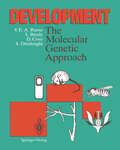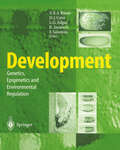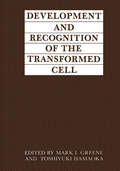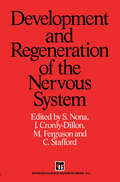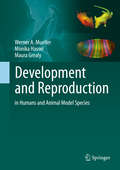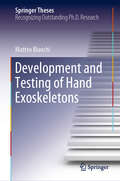- Table View
- List View
DEVELOPING THE VIRTUES C: Integrating Perspectives
by Julia Annas, Darcia Narvaez and Nancy E. SnowEthicists and psychologists have become increasingly interested in the development of virtue in recent years, approaching the topic from the perspectives of virtue ethics and developmental psychology respectively. Such interest in virtue development has spread beyond academia, as teachers and parents have increasingly striven to cultivate virtue as part of education and child-rearing. Looking at these parallel trends in the study and practice of virtue development, the essays in this volume explore such questions as: How can philosophical work on virtue development inform psychological work on it, and vice versa? How should we understand virtue as a dimension of human personality? What is the developmental foundation of virtue? What are the evolutionary aspects of virtue and its development? How is virtue fostered? How is virtue exemplified in behavior and action? How is our conception of virtue influenced by context and by developmental and social experiences? What are the tensions, impediments and prospects for an integrative field of virtue study? Rather than centering on each discipline, the essays in this volume are organized around themes and engage each other in a broader dialogue. The volume begins with an introductory essay from the editors that explains the full range of philosophical and empirical issues that have surrounded the notion of virtue in recent years.
Developing to Scale: Technology and the Making of Global Health
by Heidi MorefieldThe first critical book on “appropriate technology,” Developing to Scale shows how global health came to be understood as a problem to be solved with the right technical interventions. In 1973, economist E. F. Schumacher published Small Is Beautiful, which introduced a mainstream audience to his theory of “appropriate technology”: the belief that international development projects in the Global South were most sustainable when they were small-scale, decentralized, and balanced between the traditional and the modern. His theory gained widespread appeal, as cuts to the foreign aid budget, the national interests of nations seeking greater independence, postcolonial activism, and the rise of the United States’ tech sector drove stakeholders across public and private institutions toward cheaper tools. In the ensuing decades, US foreign assistance shifted away from massive modernization projects, such as water treatment facilities, toward point-of-use technologies like village water pumps and oral rehydration salts. This transition toward the small scale had massive implications for the practice of global health. Developing to Scale tells the history of appropriate technology in international health and development, relating the people, organizations, and events that shaped this consequential idea. Heidi Morefield examines how certain technologies have been defined as more or less “appropriate” for the Global South based on assumptions about gender, race, culture, and environment. Her study shows appropriate technology to be malleable, as different constituencies interpreted its ideas according to their own needs. She reveals how policymakers wielded this tool to both constrain aid to a scale that did not threaten Western interests and to scale the practice of global health through the development and distribution of technical interventions.
Developing to Scale: Technology and the Making of Global Health
by Heidi MorefieldThe first critical book on “appropriate technology,” Developing to Scale shows how global health came to be understood as a problem to be solved with the right technical interventions. In 1973, economist E. F. Schumacher published Small Is Beautiful, which introduced a mainstream audience to his theory of “appropriate technology”: the belief that international development projects in the Global South were most sustainable when they were small-scale, decentralized, and balanced between the traditional and the modern. His theory gained widespread appeal, as cuts to the foreign aid budget, the national interests of nations seeking greater independence, postcolonial activism, and the rise of the United States’ tech sector drove stakeholders across public and private institutions toward cheaper tools. In the ensuing decades, US foreign assistance shifted away from massive modernization projects, such as water treatment facilities, toward point-of-use technologies like village water pumps and oral rehydration salts. This transition toward the small scale had massive implications for the practice of global health. Developing to Scale tells the history of appropriate technology in international health and development, relating the people, organizations, and events that shaped this consequential idea. Heidi Morefield examines how certain technologies have been defined as more or less “appropriate” for the Global South based on assumptions about gender, race, culture, and environment. Her study shows appropriate technology to be malleable, as different constituencies interpreted its ideas according to their own needs. She reveals how policymakers wielded this tool to both constrain aid to a scale that did not threaten Western interests and to scale the practice of global health through the development and distribution of technical interventions.
Developing Your Compassion Strengths: A Guide for Healthcare Students and Practitioners
by Mark DurkinThis practical book suggests ways in which healthcare students and practitioners can develop their compassion strengths. Discussing what compassion is and means, it includes a new compassion strength model and a series of exercises the reader can use for reflecting on and developing their practice. A hallmark of healthcare practice is compassion, yet there is a lack of understanding as to what compassion is and how it can be developed in practice. The book begins with the challenge of defining compassion, particularly looking at healthcare contexts and making links between self-care and caring for others. It then presents a new, evidence-based holistic model that brings together key elements of compassion for self and other, along with a scale that readers can measure themselves against. Identifying eight strengths "self-care, connection, communication, competency, empathy, interpersonal skills, character, and engagement" Durkin provides the theoretical background to each, accompanied with suggestions for practice and reflective activities. It ends with a selection of vignettes that readers can use to try out their strengths. Highlighting the concept of compassion strengths, and compassion as a way of being, this is an essential read for healthcare students and practitioners, whether involved in direct patient care or management.
Developing Your Compassion Strengths: A Guide for Healthcare Students and Practitioners
by Mark DurkinThis practical book suggests ways in which healthcare students and practitioners can develop their compassion strengths. Discussing what compassion is and means, it includes a new compassion strength model and a series of exercises the reader can use for reflecting on and developing their practice. A hallmark of healthcare practice is compassion, yet there is a lack of understanding as to what compassion is and how it can be developed in practice. The book begins with the challenge of defining compassion, particularly looking at healthcare contexts and making links between self-care and caring for others. It then presents a new, evidence-based holistic model that brings together key elements of compassion for self and other, along with a scale that readers can measure themselves against. Identifying eight strengths "self-care, connection, communication, competency, empathy, interpersonal skills, character, and engagement" Durkin provides the theoretical background to each, accompanied with suggestions for practice and reflective activities. It ends with a selection of vignettes that readers can use to try out their strengths. Highlighting the concept of compassion strengths, and compassion as a way of being, this is an essential read for healthcare students and practitioners, whether involved in direct patient care or management.
Development: The Molecular Genetic Approach
by Vincenzo E.A. Russo Stuart Brody David Cove Sergio OttolenghiAs a result of the molecular genetic analysis of development similar mechanisms for the regulation of gene expression are found in a wide range of organisms. In "Development - the Molecular Genetic Approach" these common mechanisms as well as the specific events leading to a differentiated cell are described. Particular items treated are, for example, how asymmetry is achieved, how cell size is determined, how cell division is controlled, how cell lineage influences development, how cells know their position, and how cells communicate during development.
Development: Genetics, Epigenetics and Environmental Regulation
by F. Salamini V. E. A. Russo D. J. Cove L. G. Edgar R. JaenischStudies of organisms have led to a greatly improved understanding of the genetic mechanisms underlying developmental processes, and the epigenetic and environmental influences on these processes. This second edition reviews these three levels and their relative importance to give the reader a clear picture of one of the most exciting areas of current biological research.
Development and Approval of Combination Products: A Regulatory Perspective
by Evan B. SiegelA step-by-step, integrated approach for successful, FDA-approved combination drug products Using a proven integrated approach to combination drug development, this book guides you step by step through all the preclinical, clinical, and manufacturing stages. Written from an FDA regulatory perspective, the book not only enables you to bring a successful combination drug product to market, it also sets forth the most efficient and effective path to FDA approval. The book begins with an introductory chapter presenting definitions and basic regulatory principles of combination products. Next, it reviews manufacturing and controls, preclinical testing models, pharmacology, clinical testing, regulatory submissions, FDA reviews, and approvals. Among the key topics examined are: * The pharmacology, safety pharmacology, and toxicology supporting human clinical trials of combination products * Approaches to clinical trial protocol design and execution * Chemical, physicochemical, and analytical aspects of manufacturing controls and validation that lead to stable components for combination products * Key sponsor/FDA meetings and negotiations essential for approval and commercialization Case studies involving such actual combination products as Mylotarg, Herceptin, and HercepTest help you better understand how to implement the author's practical guidelines. References at the end of each chapter enable you to find more information on any stage of the development, manufacturing and approval processes. This book is ideal for researchers, regulators, academics, project managers, and executives involved in the complex process of combination product development. Not only does itoffer a comprehensive guide to the technical aspects of the field, it also integrates all ofthese technical aspects into a unified, effective approach to help ensure a successful, approved product.
Development and Engineering of Dopamine Neurons (Advances in Experimental Medicine and Biology #561)
by J. Peter H. Burbach Jeroen Pasterkamp Marten P. SmidtTheneurotransmitter dopamine has just celebrated its 50thbirthday. The discovery of dopamine as a neuronal entity in the late 1950s and the notion that it serves in neurotransmission has been a milestone in the field of neuroscience research. This milestone marked the beginning of an era that explored the brain as an integrated collection of neuronal systems that one could distinguish on basis of neurotransm- ter identities, and importantly, in which one started to be able to pinpoint the seat of brain disease. The mesodiencephalic dopaminergic (mdDA) system, previously designated as midbraindopaminergic system, has received much attention since its discovery. The initial identification of dopamine as a neurotransmitter in the central nervous system (CNS) and its relevance to psychiatric and neurological disorders have stimulated a plethora of neurochemical, pharmacological and genetic studies into the function of dopamine neurons and theirprojections. In the last decade, studies on gene expression and development have further increased the knowledge of this neuronal population and have unmasked a new level of complexity. The start of the molecular dissection of the mdDA system has been marked by the cloning and characterization ofNurrl and Pitx3. These transcription factors were shown to have a critical function during mdDA development. These initial studies have been followed by the identification of many other proteins, which have a crucial function in the creation of a dopamine neuron permissive region, induction of precursors, induction of terminaldifferent- tion and finally maintenance of the mdDA neuronal pool.
Development and Exploitation of Empirical Birth Weight Standards: (pdf)
by Roy Carr-Hill Colin PritchardDevelopment and Formulation of Veterinary Dosage Forms
by Gregory E. Hardee; J. Desmond BaggotAlthough the United States (U.S.) and the more developed nations of the remainder of the world are blessed with a variety of pharmaceuticals, feed additives, and biological products to treat, prevent, and control animal diseases, there is a healthy desire among persons involved in animal health issues to increase our animal medicine chest. The interest stems from the desire to efficiently produce food that is safe and plentiful and from the desire to have more and better government-approved products available for the prevention and treatment of diseases of dogs, cats, and horses and for an increasing variety of minor animal species. For the animal health industry, increased drug availability means broader markets, increased revenues, and an opportunity to better serve their customers. For the veterinarian, more animal health products means that he or she is better able to treat the usual and the unusual conditions, and to prevent animal disease and suffering. No doubt, we are all winners when new technology and industrial and regulatory initiatives hasten the availability of safe and effective animal health products.
Development and Formulation of Veterinary Dosage Forms (Drugs And The Pharmaceutical Sciences Ser.)
by Gregory E. Hardee J. D. BaggotAlthough the United States (U.S.) and the more developed nations of the remainder of the world are blessed with a variety of pharmaceuticals, feed additives, and biological products to treat, prevent, and control animal diseases, there is a healthy desire among persons involved in animal health issues to increase our animal medicine chest. The interest stems from the desire to efficiently produce food that is safe and plentiful and from the desire to have more and better government-approved products available for the prevention and treatment of diseases of dogs, cats, and horses and for an increasing variety of minor animal species. For the animal health industry, increased drug availability means broader markets, increased revenues, and an opportunity to better serve their customers. For the veterinarian, more animal health products means that he or she is better able to treat the usual and the unusual conditions, and to prevent animal disease and suffering. No doubt, we are all winners when new technology and industrial and regulatory initiatives hasten the availability of safe and effective animal health products.
Development and Implementation of Health Technology Assessment: Turning Knowledge into Action (Contributions to Management Science)
by Valentina BerettaThis book analyses the factors that influence the development and implementation of Health Technology Assessment (HTA) from multiple perspectives. It investigates the development of HTA activities in decentralized countries with a specific focus on the analysis of healthcare professionals’ perceptions. Although these perceptions are highly relevant in terms of implementing HTA processes, especially at the local level, they are rarely captured, and require further investigation, which this book provides. In particular, HTA has been introduced as a support tool for reviewing and assessing the introduction and dissemination of healthcare technologies. The book discusses how individual and organisational factors affect knowledge production and translation, and their relevance in the context of HTA. Furthermore, it explores how HTA could be more successfully implemented in decentralized healthcare systems.
Development and Manufacture of Protein Pharmaceuticals (Pharmaceutical Biotechnology #14)
by Steve L. Nail Michael J. AkersIn this era of biotechnology there have been many books covering the fundamentals of recombinant DNA technology and protein chemistry. However, not many sources are available for the pharmaceutical develop ment scientist and other personnel responsible for the commercialization of the finished dosage forms of these new biopharmaceuticals and other products from biotechnology. This text will help to fill this gap. Once active biopharmaceutical molecules are candidates for clinical trial investigation and subsequent commercialization, a number of other activities must take place while research and development on these molecules continues. The active ingredient itself must be formulated into a finished dosage form that can be conveniently used by health care professionals and patients. Properties of the biopharmaceutical molecule must be clearly understood so that the appropriate finished product formulation can be developed. Finished product formulation development includes not only the chemical formulation, but also the packaging system, the manufacturing process, and appropriate control strategies to assure such good manufacturing practice attributes as safety, identity, strength, purity, and quality.
Development and Organization of the Retina: From Molecules to Function (Nato Science Series A: #299)
by Leo M. Chalupa Barbara L. FinlayDevelopment and Organization of the Retina offers an invaluable survey of contemporary research issues and methods dealing with the retina and retinal projections. The book's 19 chapters report on investigations into two areas: research into the organization of the mature retina and work on developmental issues. A sampling of chapter topics includes -- embryonic patterning of cone subtypes in the mammalian retina -- synaptic transmission between retinal neurons -- scaling the retina, macro and micro -- retinal ganglion cell axonal transport, and more.
Development and Plasticity in Sensory Thalamus and Cortex
by Reha Erzurumlu William Guido Zoltan MolnarThis volume provides an update on the multitude of technical and experimental approaches in understanding the development and plasticity of the mammalian sensory thalamus and neocortex. The focus is on visual and somatosensory thalamus and neocortex in rodents and carnivores, and functional imaging studies in developing and aging human neocortex. It further provides a synthetic theoretical framework for future studies.
Development and Recognition of the Transformed Cell
by M. I. Greene T. HamaokaThe study of the phenotypic and genetic features that characterize the malignant cell is a rapidly growing and changing field. Clearly new insights into the processes involved in normal and abnormal cell growth will facilitate our understanding of events relevant to cancer and cellular differentiation. Early studies on genetic fea tures associated with cancer focused on chromosomal abnormalities that were observable in several human malignancies. The more recent examination of onco genes and the proteins they encode has helped pinpoint many steps in different processes that might be involved in cancer. Immunologic studies of cancer have also developed from an imprecise series of investigations to a more detailed molecular examination of cell-surface struc tures that can be recognized immunologically. In the course of the development of modern tumor immunology, it has become clear that many of the antigens that can be recognized appear to be the products of genes involved in cell growth. Fur thermore, changes in the cell surface of malignant cells have often been found to include alteration of nonprotein constituents.
Development and Regeneration of the Nervous System
by S. Nona J. R. Cronly-Dillon M. J. W. Ferguson C. StaffordDevelopment and Regenerative Capacity of Descending Supraspinal Pathways in Tetrapods: A Comparative Approach (Advances in Anatomy, Embryology and Cell Biology #154)
by H.J. ten DonkelaarIn this treatise, current knowledge on the neurogenesis, axonal outgrowth, synaptogenesis, and regenerative capacity of descending supraspinal pathways in tetrapods is discussed. Although emphasis is on the clawed toad, Xenopus laevis, chicken embryos, opossums and rodent data, also the data available for primates including man are presented. It will be shown that 1) the outgrowth of descending supraspinal pathways is the result of a coordinated program; 2) the pattern of early descending axonal tracts is similar in all vertebrate groups; 3) the formation of descending supraspinal pathways occurs according to a developmental sequence; 4) the earliest descending supraspinal fibers arrive in a rather immature spinal cord, and 5) the regenerative capacity of descending supraspinal pathways depends on the developmental stage the particular pathways arise.
Development and Reproduction in Humans and Animal Model Species
by Werner A. Mueller Monika Hassel Maura GrealyThis book describes human development including sexual reproduction and stem cell research with the development of model organisms that are accessible to genetic and experimental analysis in readily understandable texts and 315 multi-colored graphics. The introductory account of model organisms selected from the entire animal kingdom presents general principles, which are then outlined in subsequent chapters devoted to, for example, sexual development; genes controlling development and their contemporary molecular-analysis methods; production of clones and transgenic animals; development of the nervous and circulatory systems; regenerative medicine and ageing. Finally the evolution of developmental toolkits and novelties is discussed including the genetic basis of the enlargement of the human forebrain.Separate boxes are devoted to controversial questions such as the benefits and problems of prenatal diagnostics or the construction of ancient body plans.
Development and Testing of Hand Exoskeletons (Springer Theses)
by Matteo BianchiThis book describes the development of portable, wearable, and highly customizable hand exoskeletons to aid patients suffering from hand disabilities. It presents an original approach for the design of human hand motion assistance devices that relies on (i) an optimization-based kinematic scaling procedure, which guarantees a significant adaptability to the user’s hands motion, and (ii) a topology optimization-based design methodology, which allowed the design of a lightweight, comfortable device with a high level of performance. The book covers the whole process of hand exoskeleton development, from establishing a new design strategy, to the construction and testing of hand exoskeleton prototypes, using additive manufacturing techniques. As such, it offers timely information to both researchers and engineers developing human motion assistance systems, especially wearable ones.
Development and Women's Reproductive Health in Ghana, 1920-1982 (Routledge Research in Health and Healing in Africa and the African Diaspora)
by Holly AshfordThis book investigates the history of women's reproductive health in Ghana, arguing that between the 1920s and 1980s, it was largely driven by discourses of development and population control, rather than a concern for women’s health or rights. Between the 1920s and 1980s, the choices that Ghanaian women made regarding their reproductive health were defined by development policy and practice. Spanning the colonial and immediate postcolonial periods, this book demonstrates that whilst the substance of development discourse shifted over time, principles of development continued to be used to impact and legitimise reproductive health policy and practices well after independence. The book explores Ghana’s pluralist health system, the introduction of maternal and child welfare, the dominance of the Red Cross in Ghana’s maternal and child health landscape, nationalist pronatalism and global population activism. In order to understand how global iterations of development and health policy impacted on ordinary lives in Ghana, the author uses evidence from multiple ‘levels’, including private papers, national archives, and records of international and transnational organisations. Providing balanced archival perspectives, the book includes extensive oral history interviews carried out with both rural Ghanaian women and traditional birth attendants, as well as with midwives, doctors and family planning fieldworkers. This book will have an important impact on a number of historical fields including Ghanaian history, global health history, global histories of population and family planning and histories of development. It will be of interest to researchers and students in the history of public health, development, Africa, Ghana and gender.
Development and Women's Reproductive Health in Ghana, 1920-1982 (Routledge Research in Health and Healing in Africa and the African Diaspora)
by Holly AshfordThis book investigates the history of women's reproductive health in Ghana, arguing that between the 1920s and 1980s, it was largely driven by discourses of development and population control, rather than a concern for women’s health or rights. Between the 1920s and 1980s, the choices that Ghanaian women made regarding their reproductive health were defined by development policy and practice. Spanning the colonial and immediate postcolonial periods, this book demonstrates that whilst the substance of development discourse shifted over time, principles of development continued to be used to impact and legitimise reproductive health policy and practices well after independence. The book explores Ghana’s pluralist health system, the introduction of maternal and child welfare, the dominance of the Red Cross in Ghana’s maternal and child health landscape, nationalist pronatalism and global population activism. In order to understand how global iterations of development and health policy impacted on ordinary lives in Ghana, the author uses evidence from multiple ‘levels’, including private papers, national archives, and records of international and transnational organisations. Providing balanced archival perspectives, the book includes extensive oral history interviews carried out with both rural Ghanaian women and traditional birth attendants, as well as with midwives, doctors and family planning fieldworkers. This book will have an important impact on a number of historical fields including Ghanaian history, global health history, global histories of population and family planning and histories of development. It will be of interest to researchers and students in the history of public health, development, Africa, Ghana and gender.
Development as Action in Context: Problem Behavior and Normal Youth Development
by GeorgRudinger KlausEyferth Rainer K. SilbereisenMost contributions to this volume originated as papers given at an inter national conference on Integrative Perspectives on Youth Development held in Berlin (West) in May, 1983. This conference was part of a 6-year longi tudinal research program on the causes of substance use among adolescents in Berlin, which is now in its fourth year. The conference title deliberately did not refer to substance use. However, its relevance to an explanation of drug-related problem behavior was made evident to everyone invited to the conference. The search for integrative perspectives in youth development originated in a dilemma that became obvious during the planning of intensive research on concomitants of substance use. In the methodology for research on youth development, there were two lines of thought that seemed completely unre lated to each other: One line of thought was oriented toward the person, leaving situational aspects aside, while the other concentrated on ecological or situational determinants and thus neglected the aspects of development and internal processes. The integration of both these directions seemed to be an unusually promising approach for any project that aimed to understand changes in the individual within a rapidly changing urban setting. The best way to come closer to a resolution of that dilemma seemed to be an intensive exchange between the American and European scientific communities on this issue.




